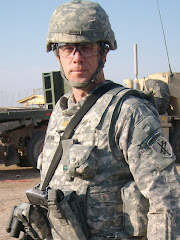Body armor has been through several generations in a very short time.
What started out as simple flack vests of bullet proof type material led to the anti-ballistic vest that had two seaparate 1/4 inch ceramic/Kevlar/mystery material plates that fit into the front and the back to give Soldiers additional protection against bullets and shrapnel. In 2005, outer arm Kevlar protectors were added. The vests then added on side plates to protect underneath arms and around the mid section.
Add the new and improved helmet, gloves, eye protection, hearing protection, elbow and knee pads, hydration kit, assault pack, and ammo pouches and you look like a 16th century knight ready to ride into battle. You are at least 2 1/2 wide at the center and its heavy as hell.
Last night I put all of that gear on for the first time. And I realized that I couldn't do it without help from my younger Soldiers. I was afraid that if I fell over that I wouldn't be able to get up and would struggle like a turtle on its back.
There is an overt gesture on the part of the highest level of the Army to provide Soldiers the most protection in battle that they possibly can. Body armor, mine resistant vehicles, advanced medicine are all proof that the military is trying to keep its causualties to a minimum. While I agree with and appreciate the gesture it is a difficult to wrap my head around.
It appears like the military want to create a zero causualty envirnoment by protecting us to the nith degree. In a low intensity conflict I suppose that is possible. The number of contacts with the enemy is falling every day and the protection provided does indeed bring Soldiers home alive. However, what happens when we face a high intensity conflict? Can we provide hundreds of thousands of Soldiers this level of protection? Or will it then be relegated to the "combatants"?
As we ponder those deeper questions - can someone help me up?
Subscribe to:
Post Comments (Atom)


No comments:
Post a Comment